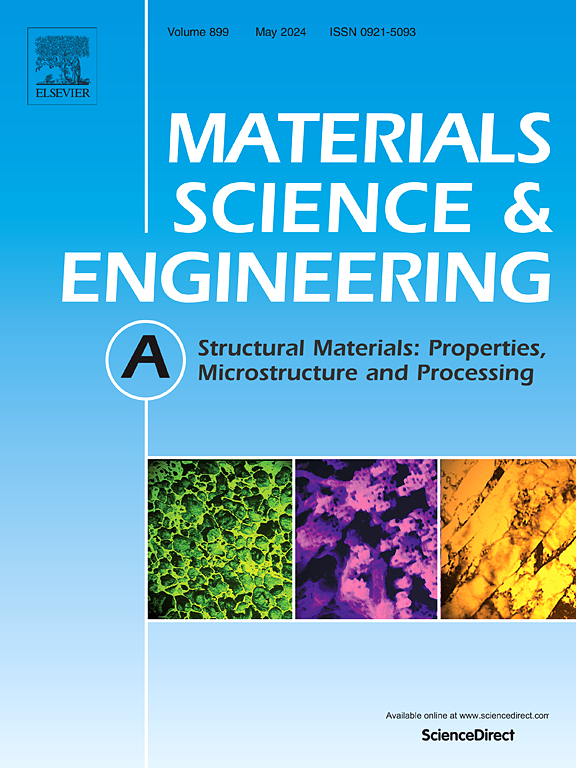Deformation mechanisms and remarkable strain hardening in a lightweight high-temperature eutectic high-entropy alloy
IF 6.1
2区 材料科学
Q1 MATERIALS SCIENCE, MULTIDISCIPLINARY
引用次数: 0
Abstract
The utilization of lightweight high entropy alloys (LWHEAs) in aerospace materials hold significant potential. However, addressing the urgent challenge of enhancing mechanical properties such as specific strength and compressive strain equilibrium at room temperature and high temperature remains a crucial problem in developing new, cost-effective structural materials. In this work, Al1.0CrVNix (x = 1.3, 1.5, 1.7, 2.0 and 2.5) and AlyCrVNi1.5 (y = 0.75, 1.25, 1.3, 1.37 and 1.5) LWHEA systems with low densities of 5.6–6.6 g cm−3, have been proposed. Two eutectic LWHEAs with B2/BCC and L21/BCC structures are obtained in Al1.0CrVNi1.7 and Al1.37CrVNi1.5, respectively. The alloys show excellent specific yield strengths of 311 and 277 MPa (g cm−3)−1, respectively (typically ∼ 220 MPa (g cm−3)−1 in conventional Ti- and Ni-based alloys at room temperature), and hardness of 648 and 568 HV, respectively (typically ∼ 480 HV in conventional Ti- and Ni-based alloys), while keeping the compressive strain over 30 %. Furthermore, Al1.37CrVNi1.5 and Al1.5CrVNi1.5 LWHEAs possess excellent mechanical properties at high temperature, whose specific yield strengths are as high as 177 and 161 MPa (g cm−3)−1 respectively at 800 °C, far exceeding those currently reported LWHEAs. The alloys exhibit significant strain hardening capability, resulting from the interaction between ordered and disordered phases with semi-coherent interfaces, along with the presence of coherent nano-precipitates dispersed throughout the eutectic phases.
一种轻质高温共晶高熵合金的变形机制和显著的应变硬化
轻质高熵合金(LWHEAs)在航空航天材料中的应用具有巨大的潜力。然而,提高材料在室温和高温下的比强度和压应变平衡等力学性能仍然是开发新型、经济高效的结构材料的关键问题。在这项工作中,提出了Al1.0CrVNix (x = 1.3, 1.5, 1.7, 2.0和2.5)和AlyCrVNi1.5 (y = 0.75, 1.25, 1.3, 1.37和1.5)低密度5.6-6.6 g cm−3的LWHEA系统。在Al1.0CrVNi1.7和Al1.37CrVNi1.5中分别获得了具有B2/BCC和L21/BCC结构的共晶LWHEAs。合金表现出优异的比屈服强度分别为311和277 MPa (g cm−3)−1(室温下传统Ti和ni基合金通常为~ 220 MPa (g cm−3)−1),硬度分别为648和568 HV(传统Ti和ni基合金通常为~ 480 HV),而压缩应变保持在30%以上。此外,Al1.37CrVNi1.5和Al1.5CrVNi1.5 LWHEAs具有优异的高温力学性能,800℃时的屈服强度分别高达177和161 MPa (g cm−3)−1,远远超过目前报道的LWHEAs。合金表现出显著的应变硬化能力,这是由于有序相和无序相之间具有半共晶界面的相互作用,以及分散在共晶相中的相干纳米析出物的存在。
本文章由计算机程序翻译,如有差异,请以英文原文为准。
求助全文
约1分钟内获得全文
求助全文
来源期刊

Materials Science and Engineering: A
工程技术-材料科学:综合
CiteScore
11.50
自引率
15.60%
发文量
1811
审稿时长
31 days
期刊介绍:
Materials Science and Engineering A provides an international medium for the publication of theoretical and experimental studies related to the load-bearing capacity of materials as influenced by their basic properties, processing history, microstructure and operating environment. Appropriate submissions to Materials Science and Engineering A should include scientific and/or engineering factors which affect the microstructure - strength relationships of materials and report the changes to mechanical behavior.
 求助内容:
求助内容: 应助结果提醒方式:
应助结果提醒方式:


